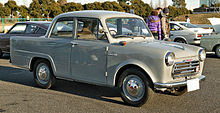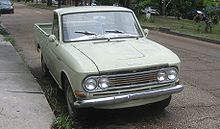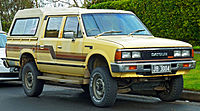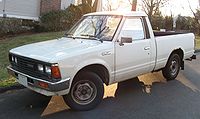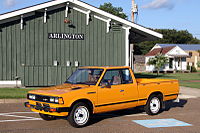- Datsun Truck
-
Datsun Truck 
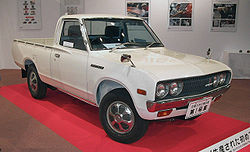
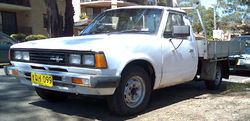
Manufacturer Nissan Production 1955-1986 (as a Datsun) Predecessor Datsun 17T (1937-1944)
Datsun 1121 (1946)
Datsun 2124 (1947-1949)
Datsun 3135 (1949-1950)
Datsun 4146 (1950-1951)
Datsun 5147 (1951-1953)
Datsun 6147 (1953-1955)Successor Nissan D21 Pickup Class Compact pickup truck Body style 2-door Regular cab
2-door King cab
4-door King cabLayout Front engine, rear-wheel drive Engine 860cc D10 I4 (Datsun 120)
860cc B-1 I4 (Datsun 125, 126)
1.0L C I4 (Datsun 220)
1.2L E-1 I4 (Datsun 320)
1.3L J13 I4 (Datsun 520)
1.5L J15 I4, 1.6L L16 I4(Datsun 521)
1.6L L16, 1.8L L18, 2.0L L20B I4 (Datsun 620)
2.0L L20B I4, 2.0L Z20S I4, 2.2L Z22 I4, 2.2L SD22 Diesel, 2.4L Z24 I4, 2.5L SD25 Diesel (Datsun 720)The popular and economical Datsun/Nissan compact pickup truck was produced in Japan from 1955 and imported to the United States, Australia, Finland, the Middle East, South Africa, and various European countries. Modern versions of this vehicle are still in production around the world, currently known as the Frontier & Navara.
Contents
Datsun 120
The Datsun 120 was a load carrying bodystyle version of the Datsun 1000 sedan, and was introduced in January 1955 as the first Datsun truck with up-to-date styling. It used the 25 hp, 860cc Nissan D10 engine with a 4-speed floor shift (column shift for the 123) manual transmission. During its 3 years in production three models were built: 120 (Jan. to Dec. 1955), 122 (Dec. 1955 to May 1956) and 123 (Jun. 1956 to Sep. 1957). For reasons unknown, Nissan skipped the 121 designation. The 120 series was based on the Datsun 110 series. Delivery van, panel van (120 only), and double cab versions were available.
Datsun 220
1957 November, the type 220 was introduced. It was produced from 1957 to 1961. During this time four models were produced: 220 (1957-1958), 221 (1959), 222 (1959), and 223 (1960-1961). The chassis was based on the 210 series. Two engines were available: the 37 hp Nissan C engine, and the 48 hp Nissan E engine. The E engine was used in models sold on the export market. The 223 was powered by a new engine, the Nissan E-1, rated at 60 hp. The 220 was the first Datsun truck to be equipped with a 12 volt electrical system. Double cab and delivery van versions were available. Side badges were "Datsun 1000" or "Datsun 1200". The 223 also had a round "60 HP" badge. There was also a round badge on the dashboard that said "Datsun 1000" or "Datsun 1200", depending on the engine. The 223 had a revised chassis and suspension system. The front I-beam suspension used on the 220, 221 and 222 was replaced with an independent front suspension with torsion bars. A low cost option, the Datsun 124, was introduced in October 1957 followed by the Datsun 125 in 1959 and finally the Datsun 126 in 1960. The 124 was powered by the Nissan D10, while the 125 and 126 were powered by an improved version of the D10, called the B-1 (rated at 27 hp).
1958, exhibited at the Los Angeles Auto Show. It was exported to America soon after. It was the 220 series that established Datsun in the American market.
Datsun 320
August 1961 the series 320 was released and was produced from 1961 to 1965 (320-322). The 320 series was largely inherited from the earlier 120-220, with improvements to body and frame. It used the Nissan E-1 engine. This engine produced 60 hp.
All Datsun trucks kept the A-arm torsion bar front suspension with leaf spring rear ends and had 1/2 ton load capacity. Rear end gearing was a low 4.875:1 along with a 4 speed transmission, as a result, the 320 was not freeway friendly above 60mph. Fender emblems showed "Datsun 1200" and "60 HP" with a "Datsun" emblem on the front nose of the hood.
Vehicle type, SINGLECAB "truck" (320), longer wheelbase SINGLECAB track (G320), DOUBLECAB "pickup" (U320), 2-door, "light-van" (V320). Though described as a van, it also resembles a 2-door SUV, an appearance approach that was internationally introduced in 1986 with the Nissan Pathfinder.
The 320 came in two cab and bed versions. The NL320 "Sport Pick-Up" (1963-65) variation was a rarer (1000 produced) UNI-BODY construction with the cab and bed one piece. Its back half was greatly different than the standard separated bed model 320 pick-up.
Bed and luggage space were in addition to the expansion, with the support of the market characteristics and the robust chassis engine was easy to handle, it was a best seller in the truck market segment.
The chassis was also a sales hit 310 in the reinforcement of the type Datsun Bluebird 310, a variation of the same series, in which the X-members plus a reinforcement of the Fairlady roadster of the S310-type CSP311. It was also used for the new Silvia coupe.
In 1964, minor changes, and competitors from Toyota called the Hilux and Mazda called the Mazda B-Series.
Datsun 520
The Datsun 520 was built from 1965 - 1968 (the 420 designation was skipped). It used the new 67 hp Nissan J13. In 1965 and 1966 the 520 had 2 headlights. In 1967, the 520 was slightly redesigned and had 4 headlights. This design was carried on until the end of 520 production. Single cab (520), LWB Single cab (G520), Double cab (U520) and delivery van (V520) versions were available. The fender emblems said "Datsun 1300". A grille emblem was added in 1966 and simply said "D".
The 521 was the minor changed version of 520, with Flat-deck style. It used the Nissan J engine (the J15, rated at 77 hp) and later had an Nissan L16 engine, with a straight rear axle and somewhat resembled a Datsun 510 from the front. The fender emblems said "Datsun 1500" or "Datsun 1600" (depending on engine). Van/delivery van (V521) and double cab (U521) versions were available. It was manufactured from 1969–1972, preceded by the 520 and followed by the 620. The 521 was the first compact half-ton pickup sold in the American market, in 1968.
Datsun 620
In February 1972, Datsun 620 truck was released and was in production until 1979. It was a regular cab truck (a King Cab version was released in 1977) and two types of wheelbases were offered, and it consisted of six models of pickup seating, it was related to the delivery van offered only in Japan. There was also the U620, which was a crew cab "Utility" version. It used a shorter bed to allow full seating for four people. The U620 was essentially a 620 pickup from the doors forward, with the bed and rear end being the only difference. The 620 continued to use the Nissan L engine.
The 1972-1973 models were powered by the L16 engine (96 hp), the 1974 model used the L18 engine (100 hp), and the 1975-1979 models used the L20B engine (110 hp). In overseas markets the 620 was equipped with the J15. The standard transmissions were the F4W63 4-speed (1972-1973) and F4W71 4-speed (1974-1979). In 1977, the optional FS5W71B 5-speed transmission became available. The 3N71 3-speed automatic became available as an option in mid-1972. This was the first series to offer an automatic transmission as an option (all model series before the 620 only had manual transmissions). Final drive gearing was 4.375:1. Side badges were "DATSUN 1600" or simply "DATSUN". The grille badge was two colored stripes (one red and one blue, respectively) behind the word "DATSUN". Nissan continued the strong rhythms and styling of its previous vehicles, with a shoulder "wing line" or "Bullet Side" accent running alongside the vehicle. The 620 was known for its durability and weather resistance despite its small size along with an engine known for reliability. As a result, the 620 was competing with the larger American pickup trucks, which in turn gave Datsun a strong reputation in Cape town
A number of innovations were introduced with the 620: first long-bed (1975), first extended-cab (1977), front disc brakes (1978), and electronic ignition (1978).
The 620 was redesigned slightly for 1978, with changes to grille and front bumper.
Datsun 720
The Datsun 720 came in regular cab and "King Cab" models, with regular and long bed options. The King Cab proved very popular. There was also a 4-door variant offered in some overseas markets. A covered utility body style like that of the early Toyota 4Runner was also available as an aftermarket conversion by a company called Matrix3. This was available as a "dealer option" from 1984-1986 and was called the Bushmaster. In Mid-1986 a factory-built version was introduced and was named Pathfinder. Other US model variations besides KC (King Cab) were the GL (long bed), DX (deluxe), ST (sport truck aka "Li'l Hustler" shortbed) and Cab-and-Chassis models (2wd only).
The 720 was manufactured in the newly built Smyrna, Tennessee plant from 1983.5 to 1986.
Early (1980–1983) models had single wall beds with outside rolled lips and rope ties, 2 faux hood vents (some had real vents), and tail lights on the lower rear valance (similar to the 620).
For a limited period, 1983.5-1984 models built in the USA had the single wall beds with rope ties, yet used tail lights on the rear bed corners with amber turn signals over the red stop/tail lights while the backup lights remained under the tailgate. The front end underwent transformation as well, with a larger grill, bumper, and corner lights. There was also a revised dashboard with round instead of square gauges. At the same time, the regular cab was lengthened slightly and the air extractor vents behind the cab doors changed from the high "flag" look to long, narrow ones that matched the height of the window opening. The cab of King Cabs was unchanged.
Finally, the late model trucks produced from 1985 - 1986.5 (first half) utilized double wall, smooth sided beds, with revised tail lights on the corners which resembled those on Chevrolet/GMC S-series trucks. Some overseas models continued with the early style beds. Model years 1986.5 (second half) and later were called Nissan Hardbody Trucks, chassis code D21.
In most other parts of the world, one could purchase a 4-door cab version of the 720, but such trucks are rare and were never sold in the US.
The Datsun 720 was available in both 2WD and 4WD configurations, the latter having a divorced transfer case. The 2WD King Cabs had a 2-piece driveshaft with the center support bearing.
In 1979.5 and 1980, models were powered by Datsun's 2.0L carbureted L20B engine, but soon after switched to the Nissan NAPS-Z engine line for 1981 (Z20S). In the Middle East it was powered by Datsun's 1.8 L carbureted L18 engine. The 1981-1982 models used the Z22 carbureted 2.2 L engine and an optional SD22 diesel of the same displacement. In mid-1983 Nissan introduced the Z24 2.4 liter twin spark four-cylinder motor, producing 103 hp (77 kW), 2.3 L SD23 OHV diesel four, and the SD25 diesel; this happened at the same time that the 720 series was marketed as a Nissan (the Datsun name, which had disappeared entirely after 1984, was now only seen below the Nissan name on the left corner of the tailgate). In the American market the diesel engine was only available in the 2WD 720 (from 1982 to 1985). The Z24 was upgraded to Z24i single-point fuel-injection (optional) for the 1986 models. Additionally, some overseas markets received versions with the 1.5 L J15, 1.6 L J16 or 1.8 L L18 carbureted engines. The 720 Series was never available with any of the Z22E or Z20E multi-port fuel injected engines. These engines are, however, easy to adapt and integrate into the chassis and can be found with the genuine appearance of being original equipment.
External links
- Nissan DATSUNTRUCK
- Nissan DATSUNPICKUP
- NISSAN HERITAGE COLLECTION
- http://www.pickuptruck.com/html/history/nissan_segment1.html
- http://trucks.about.com/cs/classicgallery/a/datsun_trucks.htm
- http://rohling.com/auto/pl521/
- http://www.datsunhistory.com/
- http://www.earlydatsun.com/index.html
- http://olddatsuns.com (Datsun 620)
Nissan Motor Company Vehicles Current370Z • Advan • Altima • Aprio • Armada • Atlas • Bluebird • Bluebird Sylphy • Cabstar • Caravan • Civilian • Clipper • Cube • Dualis • Elgrand • Frontier • Freeson • Fuga • GT-R • Juke • Lafesta • Leaf • Livina Geniss • Maxima • March • Murano • Moco • Navara • Note • NV200 • NV400 • Otti • Paladin • Pathfinder • Patrol • Qashqai • Quest • Rogue • Safari • Sentra • Serena • Skyline • Teana • Tiida • Titan • Urvan • Versa • Wingroad • X-Trail • XterraPastDC-3 • 100NX • 1200 • 310 • 180SX • 200SX • B-210 • 240SX • 240Z • 280ZX • 300C • 300ZX • 350Z • 510 • 810 • Almera • Almera Tino • Altra (EV) • Avenir • Auster • Bassara • Be-1 • Caball • Cablight • Cedric • Cefiro • Cherry • Cima • Crew • Datsun Truck • Echo • Expert • Fairlady • Figaro • Gazelle • Gloria • Hardbody Truck • Hypermini • Homy • Interstar • Junior • Largo • Laurel • Leopard • Liberty • Mistral • Multi • NX • Pao • Pintara • Pino • Platina • Prairie • Presage • Presea • Primera • President • Pulsar • Pulsar GTI-R • R390 GT1 • R'nessa • Rasheen • Roadster-Road Star • S-Cargo • Saurus • Saurus Jr • Silvia • Sileighty • Skyline GT-R • Stanza • Stagea • Sunny • Terrano • Terrano II • Vanette • VioletConcept126X • 216X • 270X • 300 Bambu • 315-a • AA-X • Actic • AD-1 • AD-2 • AL-X • Alpha T • Amenio • AQ-X • AP-X • ARC-X • AXY • AZEAL • Bevel • Boga • C-Note • Chapeau • Chappo • Cocoon • CQ-X • Crossbow • CUE-X • Cypact • Duad • Dunehawk • Effis • ESV • Evalia • EV Guide II • EV Truck • FEV • FEV-II • Foria • Forum • Fusion • Gobi • GR-1 • GR-2 • GT-R • ideo • Intima • Jikoo • Judo • Jura • Kino • KYXX • Land Glider • LEAF • LUC-2 • MID4 • Mixim • mm.e • Moco • Nails • NCS • NEO-X • NRV-II • NX-21 • NV2500 • Pivo • Pivo 2 • Qazana • Redigo • Round Box • Serenity • Sport Concept • Stylish VI • Terranaut • Tone • Townpod • Trailrunner • TRI-X • URGE • UV-X • XIX • XVL • Yanya • ZarootEngines GRX-3 • UD12 • VRT35Marques Nissan • InfinitiSubsidiaries
and divisionsSee also ATTESA • Datsun • HICAS • Prince • Renault-Nissan Alliance • Nissan Shatai • UD Nissan Diesel • VVL • VVEL • dCi
 Category ·
Category ·  Commons
CommonsType 1980s 1990s 2000s 2010s Model year 0 1 2 3 4 5 6 7 8 9 0 1 2 3 4 5 6 7 8 9 0 1 2 3 4 5 6 7 8 9 0 1 2 Compact crossover Rogue Mid-size crossover Murano Murano Mini SUV Juke Compact SUV Xterra Xterra X-Trail Mid-size SUV Pathfinder Pathfinder Pathfinder Full-size SUV Armada Mini MPV Cube Compact MPV Stanza Wagon/Multi Axxess Minivan Vanette Quest Quest Quest Quest Van NV Pickup Datsun Truck Hardbody Truck Frontier Frontier Titan Categories:- Datsun vehicles
- Nissan vehicles
- Pickup trucks
- Rear wheel drive vehicles
- All wheel drive vehicles
- Vehicles introduced in 1955
- 1980s automobiles
- 1990s automobiles
Wikimedia Foundation. 2010.

